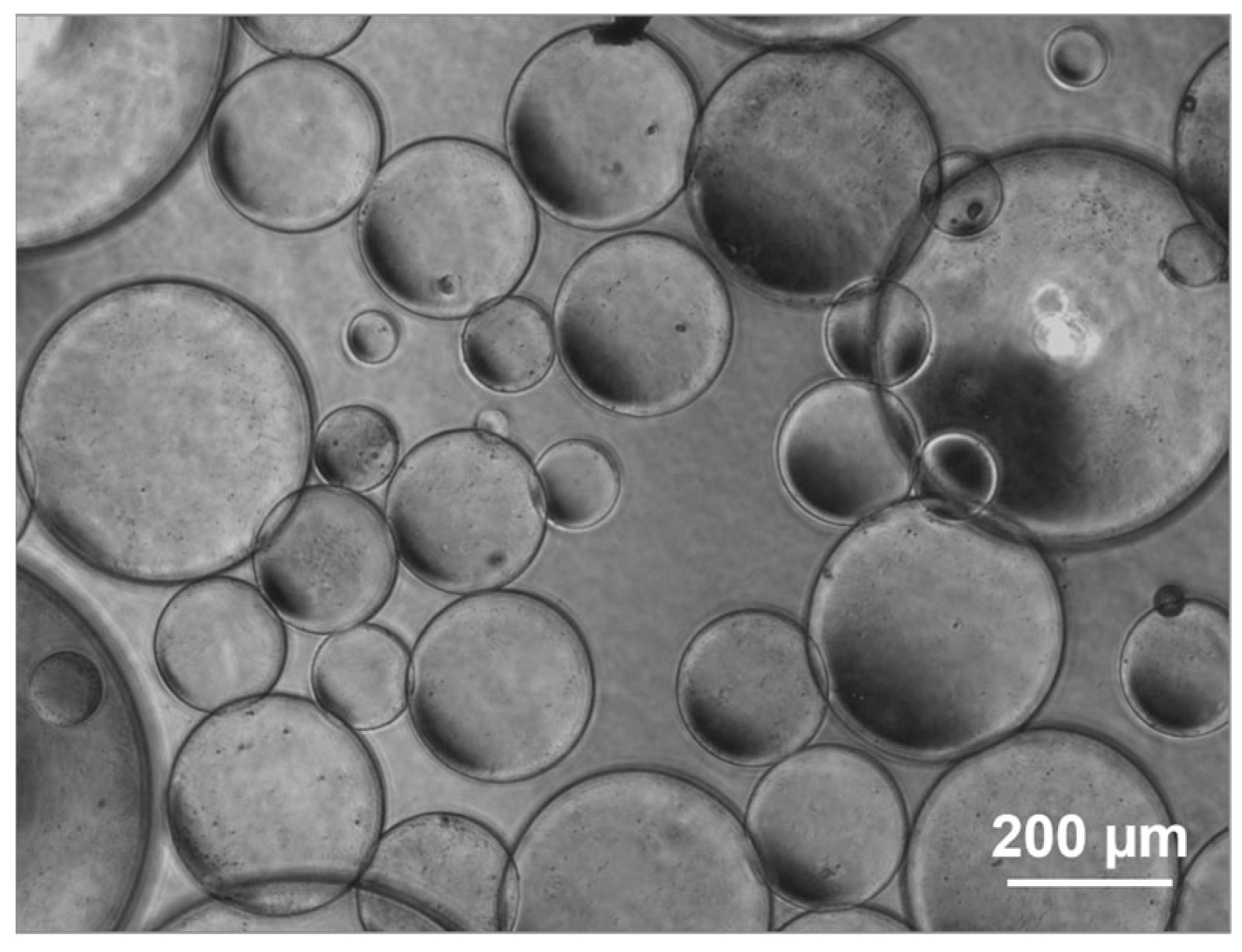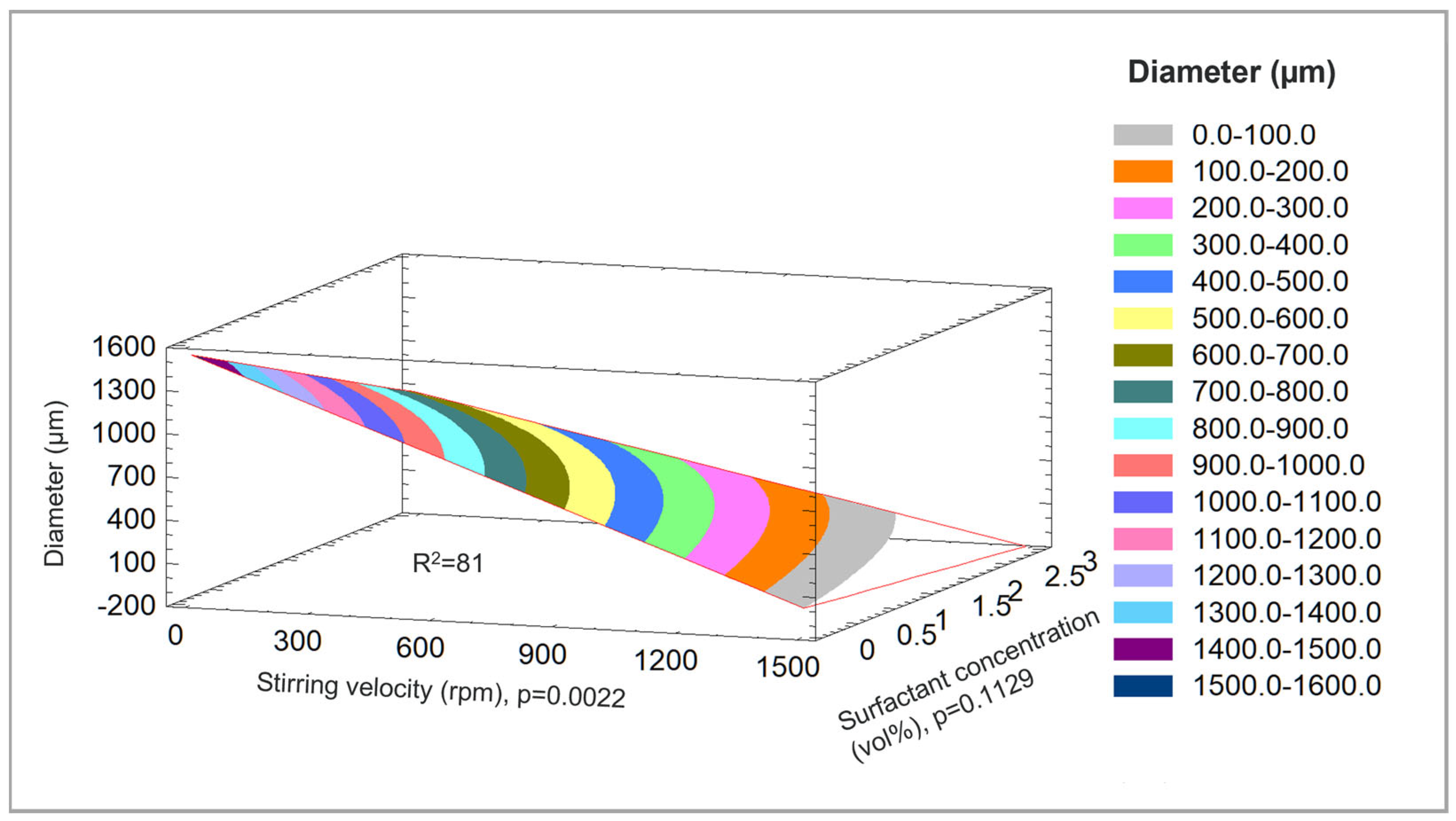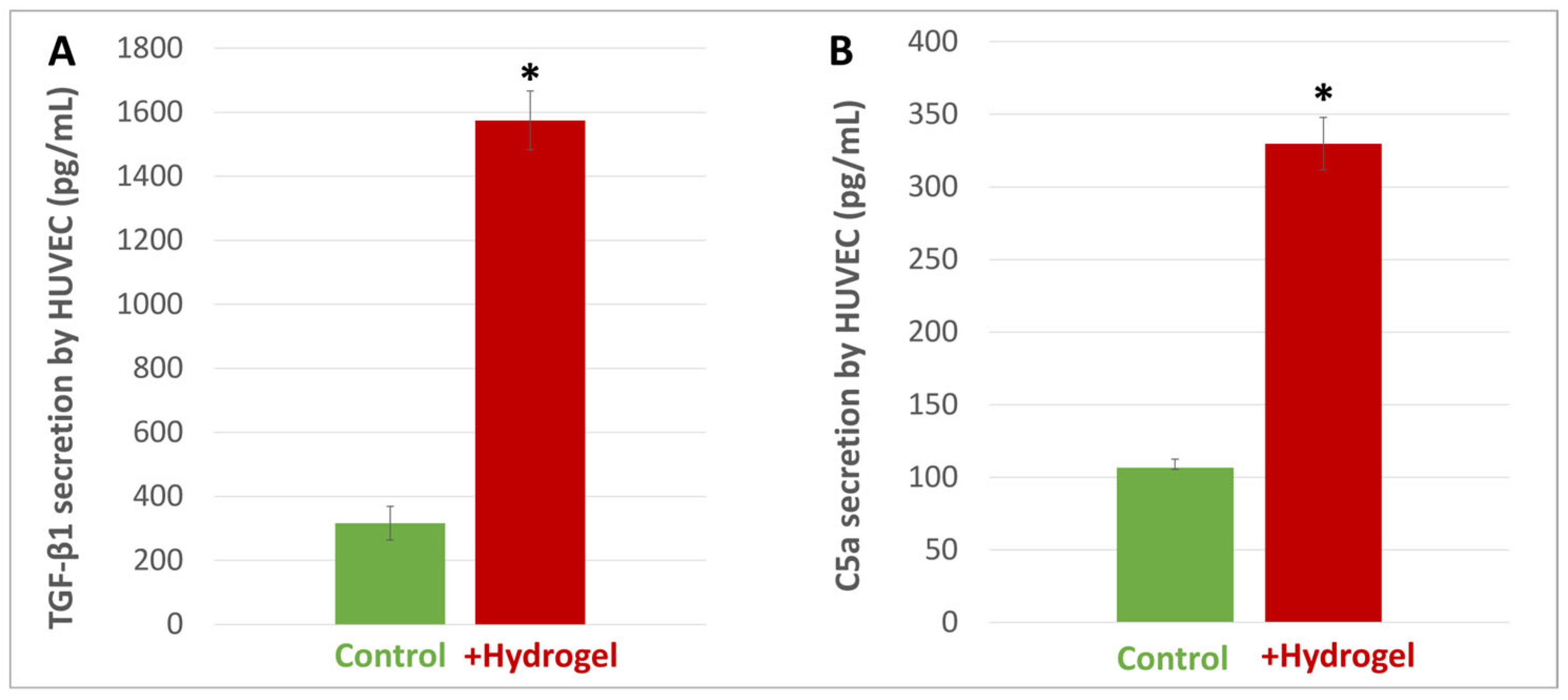Osteogenic Potential of a Polyethylene Glycol Hydrogel Functionalized with Poly-Lysine Dendrigrafts (DGL) for Bone Regeneration
Abstract
1. Introduction
2. Materials and Methods
2.1. Reagents
2.2. DGL/PEG Microspheres Preparation
2.3. Factorial Design and Characterization of DGL/PEG Microspheres
2.4. Endothelial and Mesenchymal Stem Cell Culture
2.5. Cell Treatment with the DGL/PEG Hydrogel
2.6. Cell Viability
2.6.1. Qualitative Method
2.6.2. Quantitative Method
2.7. C5 Complement Expression by Endothelial Cells
2.8. Growth Factors and C5a Complement Protein Quantification
2.9. Mesenchymal Stem Cell Migration
2.10. Mesenchymal Stem Cell ALP Activity
2.11. Statistical Analysis
3. Results
3.1. Production of Tunable Poly(L-Lysine) Dendrigrafts (DGL)/PEG-Based Hydrogel Microspheres
3.2. Poly(L-Lysine) Dendrigrafts (DGL)/PEG-Based Hydrogel Is Not Toxic
3.3. Endothelial Cells Express Complement C5 Gene
3.4. Poly(L-Lysine) Dendrigrafts (DGL)/PEG-Based Hydrogel Induces TGF-β1 and C5a Secretion from HUVECs
3.5. Incubating HUVECs with Poly(L-Lysine) Dendrigrafts (DGL)/PEG-Based Hydrogel Enhances Mesenchymal Stem Cell Migration
3.6. Poly(L-Lysine) Dendrigrafts (DGL)/PEG-Based Hydrogel Induces Mesenchymal Stem Cell Osteogenic Differentiation
4. Discussion
5. Conclusions
Author Contributions
Funding
Institutional Review Board Statement
Informed Consent Statement
Data Availability Statement
Conflicts of Interest
References
- Loi, F.; Córdova, L.A.; Pajarinen, J.; Lin, T.; Yao, Z.; Goodman, S.B. Inflammation, Fracture and Bone Repair. Bone 2016, 86, 119–130. [Google Scholar] [CrossRef] [PubMed]
- Dimitriou, R.; Jones, E.; McGonagle, D.; Giannoudis, P.V. Bone Regeneration: Current Concepts and Future Directions. BMC Med. 2011, 9, 66. [Google Scholar] [CrossRef] [PubMed]
- Zhu, G.; Zhang, T.; Chen, M.; Yao, K.; Huang, X.; Zhang, B.; Li, Y.; Liu, J.; Wang, Y.; Zhao, Z. Bone Physiological Microenvironment and Healing Mechanism: Basis for Future Bone-Tissue Engineering Scaffolds. Bioact. Mater. 2021, 6, 4110–4140. [Google Scholar] [CrossRef]
- Ho-Shui-Ling, A.; Bolander, J.; Rustom, L.E.; Johnson, A.W.; Luyten, F.P.; Picart, C. Bone Regeneration Strategies: Engineered Scaffolds, Bioactive Molecules and Stem Cells Current Stage and Future Perspectives. Biomaterials 2018, 180, 143–162. [Google Scholar] [CrossRef] [PubMed]
- Colnot, C. Skeletal Cell Fate Decisions Within Periosteum and Bone Marrow During Bone Regeneration. J. Bone Miner. Res. 2009, 24, 274–282. [Google Scholar] [CrossRef]
- Roberts, T.T.; Rosenbaum, A.J. Bone Grafts, Bone Substitutes and Orthobiologics. Organogenesis 2012, 8, 114–124. [Google Scholar] [CrossRef] [PubMed]
- Wang, W.; Yeung, K.W.K. Bone Grafts and Biomaterials Substitutes for Bone Defect Repair: A Review. Bioact. Mater. 2017, 2, 224–247. [Google Scholar] [CrossRef]
- Gibbs, D.M.R.; Black, C.R.M.; Dawson, J.I.; Oreffo, R.O.C. A Review of Hydrogel Use in Fracture Healing and Bone Regeneration. J. Tissue Eng. Regen. Med. 2016, 10, 187–198. [Google Scholar] [CrossRef]
- Giannoudis, P.V.; Dinopoulos, H.; Tsiridis, E. Bone Substitutes: An Update. Injury 2005, 36, S20–S27. [Google Scholar] [CrossRef]
- Robinson, P.G.; Abrams, G.D.; Sherman, S.L.; Safran, M.R.; Murray, I.R. Autologous Bone Grafting. Oper. Tech. Sport. Med. 2020, 28, 150780. [Google Scholar] [CrossRef]
- Spicer, C.D. Hydrogel Scaffolds for Tissue Engineering: The Importance of Polymer Choice. Polym. Chem. 2020, 11, 184–219. [Google Scholar] [CrossRef]
- Sohn, H.-S.; Oh, J.-K. Review of Bone Graft and Bone Substitutes with an Emphasis on Fracture Surgeries. Biomater. Res. 2019, 23, 9. [Google Scholar] [CrossRef] [PubMed]
- Dreifke, M.B.; Ebraheim, N.A.; Jayasuriya, A.C. Investigation of Potential Injectable Polymeric Biomaterials for Bone Regeneration. J. Biomed. Mater. Res. Part A 2013, 101, 2436–2447. [Google Scholar] [CrossRef]
- Hunt, J.A.; Chen, R.; van Veen, T.; Bryan, N. Hydrogels for Tissue Engineering and Regenerative Medicine. J. Mater. Chem. B 2014, 2, 5319–5338. [Google Scholar] [CrossRef] [PubMed]
- Ma, Z.; Gao, C.; Gong, Y.; Shen, J. Paraffin Spheres as Porogen to Fabricate Poly(L-Lactic Acid) Scaffolds with Improved Cytocompatibility for Cartilage Tissue Engineering. J. Biomed. Mater. Res. B Appl. Biomater. 2003, 67, 610–617. [Google Scholar] [CrossRef] [PubMed]
- Zaborowska, M.; Bodin, A.; Bäckdahl, H.; Popp, J.; Goldstein, A.; Gatenholm, P. Microporous Bacterial Cellulose as a Potential Scaffold for Bone Regeneration. Acta Biomater. 2010, 6, 2540–2547. [Google Scholar] [CrossRef] [PubMed]
- de Kruijff, B.; Cullis, P.R. The Influence of Poly(L-Lysine) on Phospholipid Polymorphism. Evidence That Electrostatic Polypeptide-Phospholipid Interactions Can Modulate Bilayer/Non-Bilayer Transitions. Biochim. Biophys. Acta 1980, 601, 235–240. [Google Scholar] [CrossRef]
- Huang, R.; Liu, S.; Shao, K.; Han, L.; Ke, W.; Liu, Y.; Li, J.; Huang, S.; Jiang, C. Evaluation and Mechanism Studies of PEGylated Dendrigraft Poly-L-Lysines as Novel Gene Delivery Vectors. Nanotechnology 2010, 21, 265101. [Google Scholar] [CrossRef]
- Chinnadayyala, S.R.; Park, J.; Choi, Y.; Han, J.-H.; Yagati, A.K.; Cho, S. Electrochemical Impedance Characterization of Cell Growth on Reduced Graphene Oxide–Gold Nanoparticles Electrodeposited on Indium Tin Oxide Electrodes. Appl. Sci. 2019, 9, 326. [Google Scholar] [CrossRef]
- Carrancá, M.; Griveau, L.; Remoué, N.; Lorion, C.; Weiss, P.; Orea, V.; Sigaudo-Roussel, D.; Faye, C.; Ferri-Angulo, D.; Debret, R.; et al. Versatile Lysine Dendrigrafts and Polyethylene Glycol Hydrogels with Inherent Biological Properties: In Vitro Cell Behavior Modulation and in Vivo Biocompatibility. J. Biomed. Mater. Res. 2020, 109, 926–937. [Google Scholar] [CrossRef]
- Li, X.; Ji, J.; Pu, M.; Wang, X.; Shen, J. Surface Tailoring of Poly(Ethylene Terephthalate) via Ligand-Tethered Comb-like PEG to Enhance Endothelialization. J. Mater. Sci: Mater. Med. 2008, 19, 291–299. [Google Scholar] [CrossRef] [PubMed]
- Wang, G.-X.; Deng, X.-Y.; Tang, C.-J.; Liu, L.-S.; Xiao, L.; Xiang, L.-H.; Quan, X.-J.; Legrand, A.P.; Guidoin, R. The Adhesive Properties of Endothelial Cells on Endovascular Stent Coated by Substrates of Poly-L-Lysine and Fibronectin. Artif. Cells Blood Substit. Biotechnol. 2006, 34, 11–25. [Google Scholar] [CrossRef] [PubMed]
- Lu, H.; Guo, L.; Kawazoe, N.; Tateishi, T.; Chen, G. Effects of Poly(L-Lysine), Poly(Acrylic Acid) and Poly(Ethylene Glycol) on the Adhesion, Proliferation and Chondrogenic Differentiation of Human Mesenchymal Stem Cells. J. Biomater. Sci. Polym. Ed. 2009, 20, 577–589. [Google Scholar] [CrossRef] [PubMed]
- Tian, B.; Wang, N.; Jiang, Q.; Tian, L.; Hu, L.; Zhang, Z. The Immunogenic Reaction and Bone Defect Repair Function of ε-Poly-L-Lysine (EPL)-Coated Nanoscale PCL/HA Scaffold in Rabbit Calvarial Bone Defect. J. Mater. Sci. Mater. Med. 2021, 32, 63. [Google Scholar] [CrossRef] [PubMed]
- Kim, Y.S.; Chien, A.J.; Guo, J.L.; Smith, B.T.; Watson, E.; Pearce, H.A.; Koons, G.L.; Navara, A.M.; Lam, J.; Scott, D.W.; et al. Chondrogenesis of Cocultures of Mesenchymal Stem Cells and Articular Chondrocytes in Poly(l-Lysine)-Loaded Hydrogels. J. Control. Release 2020, 328, 710–721. [Google Scholar] [CrossRef] [PubMed]
- Heo, J.S.; Kim, H.O.; Song, S.Y.; Lew, D.H.; Choi, Y.; Kim, S. Poly-L-Lysine Prevents Senescence and Augments Growth in Culturing Mesenchymal Stem Cells Ex Vivo. Biomed. Res. Int. 2016, 2016, 8196078. [Google Scholar] [CrossRef] [PubMed]
- Lorion, C.; Faye, C.; Maret, B.; Trimaille, T.; Régnier, T.; Sommer, P.; Debret, R. Biosynthetic Support Based on Dendritic Poly(L-Lysine) Improves Human Skin Fibroblasts Attachment. J. Biomater. Sci. Polym. Ed. 2014, 25, 136–149. [Google Scholar] [CrossRef]
- Zhu, C.; Hard, C.; Lin, C.; Gitsov, I. Novel Materials for Bioanalytical and Biomedical Applications: Environmental Response and Binding/Release Capabilities of Amphiphilic Hydrogels with Shape-Persistent Dendritic Junctions. J. Polym. Sci. Part A Polym. Chem. 2005, 43, 4017–4029. [Google Scholar] [CrossRef]
- Grinstaff, M.W. Dendritic Macromers for Hydrogel Formation: Tailored Materials for Ophthalmic, Orthopedic, and Biotech Applications. J. Polym. Sci. Part A Polym. Chem. 2008, 46, 383–400. [Google Scholar] [CrossRef]
- Griveau, L.; Lafont, M.; le Goff, H.; Drouglazet, C.; Robbiani, B.; Berthier, A.; Sigaudo-Roussel, D.; Latif, N.; Visage, C.L.; Gache, V.; et al. Design and Characterization of an in Vivo Injectable Hydrogel with Effervescently Generated Porosity for Regenerative Medicine Applications. Acta Biomater. 2021, 140, 324–337. [Google Scholar] [CrossRef]
- Francoia, J.-P.; Vial, L. Everything You Always Wanted to Know about Poly-L-Lysine Dendrigrafts (But Were Afraid to Ask). Chem. Eur. J. 2018, 24, 2806–2814. [Google Scholar] [CrossRef] [PubMed]
- Hossain, K.M.Z.; Patel, U.; Ahmed, I. Development of Microspheres for Biomedical Applications: A Review. Prog. Biomater. 2015, 4, 1–19. [Google Scholar] [CrossRef] [PubMed]
- Zhao, Z.; Wang, Z.; Li, G.; Cai, Z.; Wu, J.; Wang, L.; Deng, L.; Cai, M.; Cui, W. Injectable Microfluidic Hydrogel Microspheres for Cell and Drug Delivery. Adv. Funct. Mater. 2021, 31, 2103339. [Google Scholar] [CrossRef]
- Hu, X.; Shen, H.; Yang, F.; Liang, X.; Wang, S.; Wu, D. Modified Composite Microspheres of Hydroxyapatite and Poly(Lactide-Co-Glycolide) as an Injectable Scaffold. Appl. Surf. Sci. 2014, 292, 764–772. [Google Scholar] [CrossRef]
- Wu, Y.; Lu, Y.; Zhao, M.; Bosiakov, S.; Li, L. A Critical Review of Additive Manufacturing Techniques and Associated Biomaterials Used in Bone Tissue Engineering. Polymers 2022, 14, 2117. [Google Scholar] [CrossRef] [PubMed]
- Liu, S.; Jiang, T.; Guo, R.; Li, C.; Lu, C.; Yang, G.; Nie, J.; Wang, F.; Yang, X.; Chen, Z. Injectable and Degradable PEG Hydrogel with Antibacterial Performance for Promoting Wound Healing. ACS Appl. Bio Mater. 2021, 4, 2769–2780. [Google Scholar] [CrossRef]
- Mosallanezhad, P.; Nazockdast, H.; Ahmadi, Z.; Rostami, A. Fabrication and Characterization of Polycaprolactone/Chitosan Nanofibers Containing Antibacterial Agents of Curcumin and ZnO Nanoparticles for Use as Wound Dressing. Front. Bioeng. Biotechnol. 2022, 10, 1027351. [Google Scholar] [CrossRef] [PubMed]
- Yuan, Y.; Shi, X.; Gan, Z.; Wang, F. Modification of Porous PLGA Microspheres by Poly-l-Lysine for Use as Tissue Engineering Scaffolds. Colloids Surf. B Biointerfaces 2018, 161, 162–168. [Google Scholar] [CrossRef]
- Mauney, J.R.; Blumberg, J.; Pirun, M.; Volloch, V.; Vunjak-Novakovic, G.; Kaplan, D.L. Osteogenic Differentiation of Human Bone Marrow Stromal Cells on Partially Demineralized Bone Scaffolds in Vitro. Tissue Eng. 2004, 10, 81–92. [Google Scholar] [CrossRef]
- Lieberman, J.R.; Daluiski, A.; Einhorn, T.A. The Role of Growth Factors in the Repair of Bone. Biology and Clinical Applications. J. Bone Joint. Surg. Am. 2002, 84, 1032–1044. [Google Scholar] [CrossRef]
- Bessa, P.C.; Casal, M.; Reis, R.L. Bone Morphogenetic Proteins in Tissue Engineering: The Road from the Laboratory to the Clinic, Part I (Basic Concepts). J. Tissue Eng. Regen. Med. 2008, 2, 1–13. [Google Scholar] [CrossRef] [PubMed]
- Abdulahy, S.B.; Esmaeili Bidhendi, M.; Vaezi, M.R.; Moosazadeh Moghaddam, M. Osteogenesis Improvement of Gelatin-Based Nanocomposite Scaffold by Loading Zoledronic Acid. Front. Bioeng. Biotechnol. 2022, 10, 890583. [Google Scholar] [CrossRef] [PubMed]
- Zuo, Y.; Li, Q.; Xiong, Q.; Li, J.; Tang, C.; Zhang, Y.; Wang, D. Naringin Release from a Nano-Hydroxyapatite/Collagen Scaffold Promotes Osteogenesis and Bone Tissue Reconstruction. Polymers 2022, 14, 3260. [Google Scholar] [CrossRef] [PubMed]
- Sartain, S.E.; Turner, N.A.; Moake, J.L. TNF Regulates Essential Alternative Complement Pathway Components and Impairs Activation of Protein C in Human Glomerular Endothelial Cells. J. Immunol. 2016, 196, 832–845. [Google Scholar] [CrossRef] [PubMed]
- Morris, K.M.; Aden, D.P.; Knowles, B.B.; Colten, H.R. Complement Biosynthesis by the Human Hepatoma-Derived Cell Line HepG2. J. Clin. Investig. 1982, 70, 906–913. [Google Scholar] [CrossRef] [PubMed]
- Lubbers, R.; van Essen, M.F.; van Kooten, C.; Trouw, L.A. Production of Complement Components by Cells of the Immune System. Clin. Exp. Immunol. 2017, 188, 183–194. [Google Scholar] [CrossRef]
- Ehrnthaller, C.; Ignatius, A.; Gebhard, F.; Huber-Lang, M. New Insights of an Old Defense System: Structure, Function, and Clinical Relevance of the Complement System. Mol. Med. 2011, 17, 317–329. [Google Scholar] [CrossRef]
- Chmilewsky, F.; Jeanneau, C.; Laurent, P.; About, I. Pulp Fibroblasts Synthesize Functional Complement Proteins Involved in Initiating Dentin-Pulp Regeneration. Am. J. Pathol. 2014, 184, 1991–2000. [Google Scholar] [CrossRef]
- Ignatius, A.; Schoengraf, P.; Kreja, L.; Liedert, A.; Recknagel, S.; Kandert, S.; Brenner, R.E.; Schneider, M.; Lambris, J.D.; Huber-Lang, M. Complement C3a and C5a Modulate Osteoclast Formation and Inflammatory Response of Osteoblasts in Synergism with IL-1β. J. Cell. Biochem. 2011, 112, 2594–2605. [Google Scholar] [CrossRef]
- Ignatius, A.; Ehrnthaller, C.; Brenner, R.E.; Kreja, L.; Schoengraf, P.; Lisson, P.; Blakytny, R.; Recknagel, S.; Claes, L.; Gebhard, F.; et al. The Anaphylatoxin Receptor C5aR Is Present during Fracture Healing in Rats and Mediates Osteoblast Migration in Vitro. J. Trauma 2011, 71, 952–960. [Google Scholar] [CrossRef]
- Jeanneau, C.; Le Fournis, C.; About, I. Xenogeneic Bone Filling Materials Modulate Mesenchymal Stem Cell Recruitment: Role of the Complement C5a. Clin. Oral Investig. 2019, 24, 2321–2329. [Google Scholar] [CrossRef] [PubMed]
- Janssens, K.; ten Dijke, P.; Janssens, S.; Van Hul, W. Transforming Growth Factor-Β1 to the Bone. Endocr. Rev. 2005, 26, 743–774. [Google Scholar] [CrossRef] [PubMed]
- Tang, Y.; Wu, X.; Lei, W.; Pang, L.; Wan, C.; Shi, Z.; Zhao, L.; Nagy, T.R.; Peng, X.; Hu, J.; et al. TGF-Beta1-Induced Migration of Bone Mesenchymal Stem Cells Couples Bone Resorption with Formation. Nat. Med. 2009, 15, 757–765. [Google Scholar] [CrossRef] [PubMed]








Disclaimer/Publisher’s Note: The statements, opinions and data contained in all publications are solely those of the individual author(s) and contributor(s) and not of MDPI and/or the editor(s). MDPI and/or the editor(s) disclaim responsibility for any injury to people or property resulting from any ideas, methods, instructions or products referred to in the content. |
© 2023 by the authors. Licensee MDPI, Basel, Switzerland. This article is an open access article distributed under the terms and conditions of the Creative Commons Attribution (CC BY) license (https://creativecommons.org/licenses/by/4.0/).
Share and Cite
Roumani, S.; Jeanneau, C.; Giraud, T.; Cotten, A.; Laucournet, M.; Sohier, J.; Pithioux, M.; About, I. Osteogenic Potential of a Polyethylene Glycol Hydrogel Functionalized with Poly-Lysine Dendrigrafts (DGL) for Bone Regeneration. Materials 2023, 16, 862. https://doi.org/10.3390/ma16020862
Roumani S, Jeanneau C, Giraud T, Cotten A, Laucournet M, Sohier J, Pithioux M, About I. Osteogenic Potential of a Polyethylene Glycol Hydrogel Functionalized with Poly-Lysine Dendrigrafts (DGL) for Bone Regeneration. Materials. 2023; 16(2):862. https://doi.org/10.3390/ma16020862
Chicago/Turabian StyleRoumani, Sandra, Charlotte Jeanneau, Thomas Giraud, Aurélie Cotten, Marc Laucournet, Jérôme Sohier, Martine Pithioux, and Imad About. 2023. "Osteogenic Potential of a Polyethylene Glycol Hydrogel Functionalized with Poly-Lysine Dendrigrafts (DGL) for Bone Regeneration" Materials 16, no. 2: 862. https://doi.org/10.3390/ma16020862
APA StyleRoumani, S., Jeanneau, C., Giraud, T., Cotten, A., Laucournet, M., Sohier, J., Pithioux, M., & About, I. (2023). Osteogenic Potential of a Polyethylene Glycol Hydrogel Functionalized with Poly-Lysine Dendrigrafts (DGL) for Bone Regeneration. Materials, 16(2), 862. https://doi.org/10.3390/ma16020862







